By David Truby
Through no fault of her own, Jessica Lynch accidentally and unwillingly restarted the bitter war of women in combat in the U.S. military. When the high command at the Pentagon gave her an unearned Bronze star in 2003, the cynical media created her as a heroine and the feminist movement shot their own principles in the foot by idolizing this innocent young woman. The simple truth is, while doing her job, she was a casualty of an enemy ambush in Iraq.
Thousands of miles distant and light years away in a spectrum of personal courage unknown to 99% of all Americans, had they known about all that hoopla, a small group of elderly women must have chuckled with that sardonic, depreciating humor so characteristic of Russians.
While U.S. military management wrestles with the politically sensitive issues of American women in combat, the Russian armed forces have had women on their firing line for war after war after war.
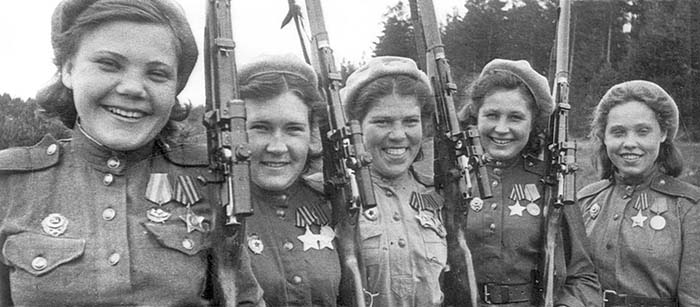
The Soviet Constitution clearly states in Article 133, “The defense of the Fatherland is the sacred duty of every citizen of the USSR.” More than 800,000 Soviet female soldiers, some as young as 15, experienced WWII combat, with the deadliest service coming as snipers, a role at which those women excelled. When it came to military snipers in WWII, Soviet women wrote the manual.
The Soviet WWII sniper rifle was a modified version of their standard issue Mosin-Nagent 1891/30, known as the M91/30. It was an 11.3 pound rifle with a five-round integral magazine, firing the 7.62x54R round with a 150-grain bullet. The sniper version rifles were factory verified for true accuracy, then modified by having the bolt turned down and addition of a telescopic sight. Earlier rifles were issued a 4-power PE model telescope, while later ones had a 3.5 power PU model telescope. The PU telescope was shorter and had no focus ring, therefore the shooter had to have excellent or corrected vision. The more popular PE model had a focus ring and was well-liked among snipers, according to most histories. The M91/30 rifles were produced by the USSR from 1937 until 1963. Some Eastern European nations were using the M91/30 sniper rifles into the 1970s.
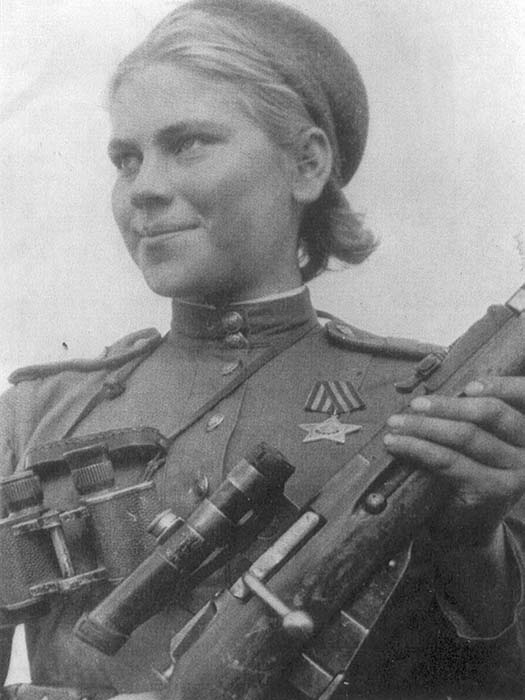
Most Russian World War II snipers, male and female, preferred the M91/30 to the newer SVT 40, a semi-automatic rifle firing the same cartridge, because it was more reliable and the bolt action made no noise. Although the rapid second shot of the self-loader was technically an advantage, in that combat environment, jams and misfeeds were common and the mechanical action was a sound signature snipers did not need.
The Soviets began serious development of a sniper program along with development of “modern” optical sights in the 1920s. The first experimental Soviet M91/30 sniper rifles were equipped with German Zeiss-Dialyther model optical sights.
The first production rifles coming from the Tula Arsenal were equipped with the Emil Busch AG model VP scope, with issue running until 1942. Sniper rifles were also produced at the Iszeusk arsenal, which are the more commonly encountered models.
That’s the cold technical side. Now, for the heat of the battle. Stalingrad was the first publicized glory for the USSR’s women snipers. According to The New York Times military editor, the late Hanson W. Baldwin, “Women snipers made a fantastic contribution to that Soviet turnaround victory and not only in a propaganda sense. They used those women snipers in brilliant fashion, and they were among the most deadly and proficient snipers I knew of during the war.”
Laza Mironova, famed sniper of the Soviet Marine Corps, was credited with over 100 kills during the siege at Stalingrad alone. Later, in street fighting near Moscow she would kill 32 German officers in a single day.
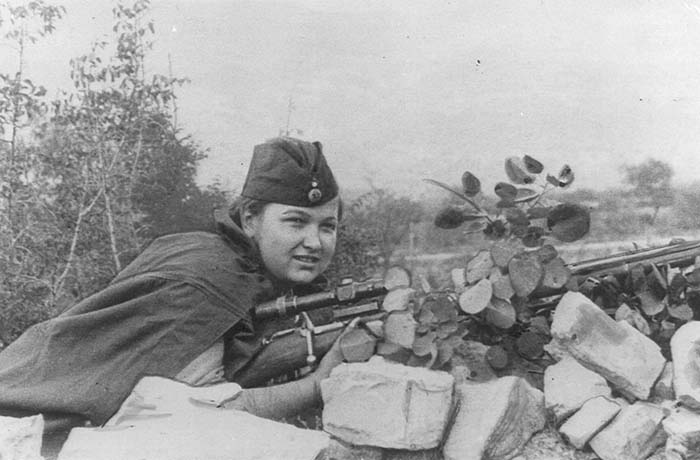
Photo credit: Novosti Press Agency.
According to the late Dan West, a WWII Hearst News Service reporter, “Snipers doing general firing could count only confirmed kills of officers and NCOs. Hits on other ranks weren’t recorded in that body count, so Mironova’s total was much higher.” He added, “This Mironova girl had a lot of medals hanging on her when I saw her in Moscow in December of 1943… She got a personal award from Stalin himself that January. After the war, I learned she was killed in the early spring of ’44.”
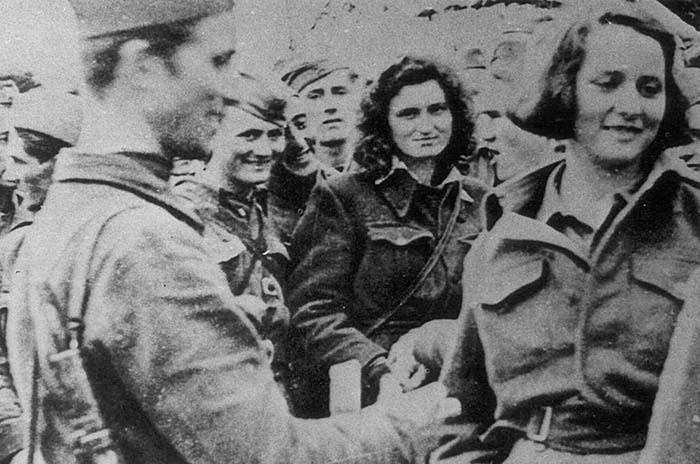
Photo credit: Novosti Press Agency.
Another highly decorated female sniper was Ziba Ganiyeva, who had nearly 300 official kills to her credit at war’s end. Retired as the highest ranking woman in the Red Army in the late ’80s, this General Officer was regarded as one of the coolest shots among the entire WWII soviet sniper corps, male or female.
Litva Rugo had a quantity of what military strategists called “quality kills,” i.e., 118 of her kills were German officers above the rank of 1st Lieutenant. Her official total kill was 275. “We were told that killing its leaders would destroy the German army, so that’s what we did,” she explained in an interview in a Soviet military magazine in 1980. Her commanding officer added, “We told Rugo that killing officers was important as it broke their chain of command and shattered morale. She was dedicated to that order… This courageous People’s Army Hero was only 20 years old then, and will always have an honored place in the history of the USSR.”
Gen. Vasili Chuikov, the leader who broke the German stranglehold on Stalingrad and is considered the hero of that battle by USSR historians, praised the women snipers in his wartime journal, writing, “These truly heroic comrades did much to turn the battle for our honored defenders with their dedication, duty, bravery, and sharp aim… These Soviet women killed many leaders among the Nazi hordes which ran loose in our country.”
In September of 1942, a German lieutenant wrote to his wife, “We no longer measure our progress in these streets by meters, but by German corpses…our boys are falling to these women soldiers the Soviets use as sharpshooters.”
Gunther Rhine, a Wermacht NCO who survived the end at Stalingrad thanks to air evacuation after his third major wounding, said, “I was totally afraid of the Soviet women soldiers, most of whom were about as humane as the shooting end of a machine pistol. They were damned good shots, too, and cool, very cool customers…made grand snipers.
“In my two years on the Eastern front I learned that the Soviet female soldier was every bit as violently attuned as her male counterparts. In soviet combat outfits it didn’t matter if soldiers were male or female. All that mattered is how well and how many of us they killed.”
That morbid view was echoed by former U.S. Army Capt. Tom Samuels, who was a liaison officer with the Soviet army in 1944. After the war, he wrote, “One theme kept coming to me in the field reports I read and from my discussions with Soviet soldiers of both sexes and the few German POWs I spoke with, that for sheer courage, brutal efficiency and killing calm under fire, the Soviet female snipers were always mentioned in awe.”
That was the Soviet Union; its back to the wall, with everyone fighting the German invaders. Any competent social scientist can tell you about territorial imperative and its effect upon aggression levels. In an interview with the late Dr. Margaret Meade, she was emphatic that women are inherently far more brutal than men and that given the circumstances women will be far more deadly soldiers than men.
Dr. Meade noted, “Examine the biological sciences or anthropology, read military histories for documentation. It is true, if you give the weapons and means of war to women, and if they have a cause, they will fight for keeps. There are no rules for the aroused female defending her young, her family or their territory. There is no built-in chivalry here, she’ll fight to the attacker’s death.”
So, the lethal capability is there and needs only to be activated and channeled. While male soldiers may be physically stronger than females, if each is using a relatively easily handled weapon, e.g., a sniper’s rifle, the dominant male strength means nothing.
According to Dr. Larry Swensen, a psychologist who worked with the U.S. Army’s Marksmanship Training Unit during the Vietnam War, “With a sniper, killing is much more of a mental than a physical action. An ideal sniper has cool, detached reactions coupled with competitive achievement. Steady nerves and an ability to handle targeting situations are vital…Many times women are better suited to this role than men…one of the strongest proofs for this is the performance of the women snipers the Soviets used in WWII…”
One of the fabled Russian snipers who survived WWII rose to command rank as a field grade officer. Vrna Zworykin retired with the rank of Colonel in 1974. From 1941 until 1943, though, she was one of their army’s top snipers, serving everyday, except for brief leaves, on the front lines. She was awarded a commission after fighting off German invaders who overran her unit’s positions. As one Soviet propagandist wrote at the time, “She traded her telescope-equipped Mosin-Nagant M1891/30 sniper rifle for a PPSh submachine gun to cover that close combat.”
According to Soviet records, Vrna Zworykin killed 85 German officers in the summer of 1942 alone. In her “pitched battle with the overrunning German raiding party,” she was credited with 60 total kills. After being commissioned she was assigned to training duties, although she personally led a team of snipers into Germany early in 1945 to target high-ranking German officers.
Earlier, during the summer of 1943, the Soviets assigned a team of five women snipers to the Baltic area for special missions. Within a three month period they had a group total of 197 German officers and two Nazi political leaders on their dead list. One of these women sharpshooters had some exposure to the British SOE.
A former SOE sergeant, the late T.J. Guthrie, was assigned as a liaison between Soviet partisans and the British. He worked with the unit to which “Zelda”, the sniper’s codename, was assigned. He said, “She was a top shot and showed little emotion in action. Otherwise, I found her to be a sweet lady. She had pretty good English.”
“I was evacuated late in 1943, and before departing I gave her my ‘scoped Enfield rifle, which one of our tradesmen had really tuned for accuracy. I believe she was genuinely touched. She told me she would use this against the invaders of her country.” The Soviets also assigned women snipers to partisan units in many of the other areas in which fighting occurred. In the Balkans, Ekaterina Zhdanov’s dead body was worth a German-paid reward the equivalent of $25,000 American dollars because of her success as a sniper.
She was the deadly sniper who had 155 German officers and senior NCOs to her kill list credit when she disappeared and was presumed dead after a heavy partisan-German battle in Bulgaria late in 1943. In addition to her sniping abilities, Lt. Zhdanov was also the commander of her partisan group.
Another Soviet female officer behind sniper’s crosshairs was Tari Vucinich, who operated in the Ukraine before, during and after the Germans swept through the area. Lt. Vucinich was mentioned in Soviet war histories as “a premier huntress and killing shot who terrorized Nazi barbarians.” When the Soviets began to push back the Germans she waited for the front line to roll up to her, sniping retreating German officers on their way out. She was credited with 155 kills before dying in a Luftwaffe attack on her unit in 1944.
The late Luther Asch was a German veteran who fought against these snipers during the retreat from the USSR. He reported, “I was witness to a sniper who hit five of my fellow officers in one day, never closer than 200 meters. One shot, one officer dead…five times. We found out it was a woman because one of our scouts wounded her and we captured her. She was about 30 years old and tough as the country we were fighting in. We patched her up best we could and an SS man came to take her away for interrogation, I guess.”
Former Capt. Asch’s uncertain comment about the sniper’s fate is because the Germans usually treated snipers like partisans and spies by taking them over the hill and shooting them.
Andor Dverk, a WWII Yugoslavian partisan, recalled a Soviet officer known to his people as “Vera,” saying, “She was a very special shot with that telescope rifle. She had 32 Germans to her credit at Stalingrad and told me she had killed 18 Nazi officers in other battles. She personally shot 18 while with us.”
In Poland, in 1945, the late Col. Jerry Sage, an OSS legend who was then a Captain, remembers stopping to pick up a Russian soldier hitchhiking in a snow blizzard. Capt Sage wrote that he noticed a rifle with a sniperscope over the soldier’s shoulder and asked in his poor Russian about sniping. The grinning response was “Da, da, over thirty Germans dead.” The young soldier also showed him the Red Star of Stalingrad and other awards for combat bravery.
“To our surprise there was ample evidence from the well-rounded and filled blouse that this soldier was a woman. She laughed at our surprise, pulled off her fur chapka cap and shook loose long blond hair,” Jerry Sage writes. “She looked a little like Sonja Henie, the skater and movie star, but, she described how she stalked and lined up her German targets like the professional assassin she was…When we neared her unit she waved us a cheery good-bye.”
Writing about women snipers, Gen. Vasili Chuikov noted, “All Soviet people fought to save the homeland, men and women together. Our women made very good sharpshooters…and they killed because they had to. Enemy bullets make no distinction of male or female target, why should ours?”
Dwight Eisenhower, Supreme Allied Commander during WWII, wrote in his memoirs, “While the United States worried about women being too effective as camp followers or not being effective enough as typists and file clerks, Russian women were already in the front lines, spilling their blood and that of the invading Germans…The best of these women were those deadly snipers who helped save the Soviet Union.”
One of those tough Russian female warriors, a marine named Katyusha Mikhaylova, told one historian, “Just before battle, a male marine handed me a baby’s pacifier and said, ‘When we go into battle we won’t have time to baby you, so take this. I told him, ‘We’ll see who is going to take care of whom.’”
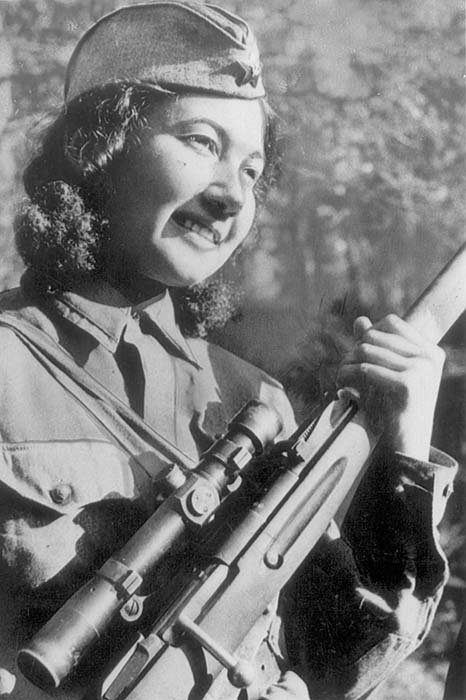
Photo creduit, Novosti Press Agency.
In one of those forgettable, Saturday afternoon, Technicolor westerns of the war years, cowboy star Randolph Scott said, “A gun is the equalizer between a big man and a little man.” The same principle applies to the sexes.
| This article first appeared in Small Arms Review V9N7 (April 2006) |










